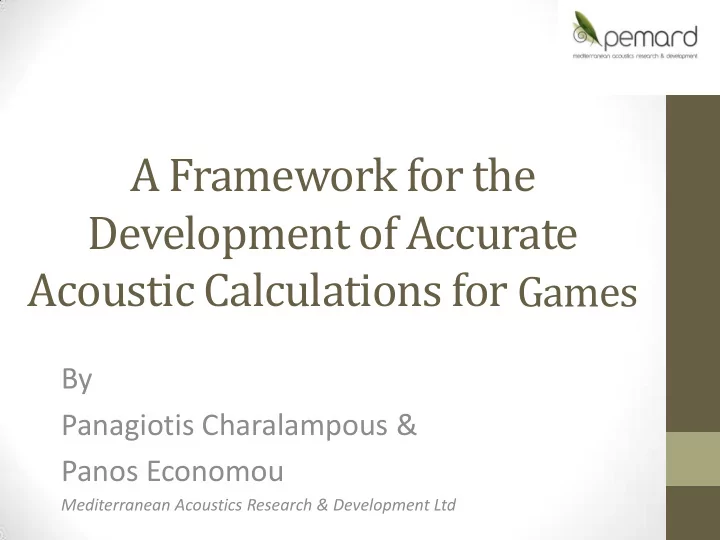

A Framework for the Development of Accurate Acoustic Calculations for Games By Panagiotis Charalampous & Panos Economou Mediterranean Acoustics Research & Development Ltd
Historical Development Late 1970’s – Early 1980’s : Slow Processing Times (Naïve algorithms, slow CPUs) Engineering Audio for Games Applications • • Prediction Speed • • Accuracy Interactivity 2013 : Fast Processing Times (Advanced Algorithms, multicore CPUs, Programmable GPUs) Fast and accurate predictions for both interactive and engineering applications
What is a Framework An abstraction in which a software offering generic functionality can be selectively changed by user code, resulting in a specific software Inversion of Control Default Behavior Framework Non-modifiable Extensibility Code
PEMARD Framework • A software architectural model which outlines a pattern that can be used in sound propagation calculations and defines a process for the calculation of sound propagation in 3D environments. PEMARD Framework . Geometrical Acoustics Loose Coupling Combination of Methodologies
Sound Rendering Process Path Path Detection Calculation Optimization Preprocessing Auralization
Sequence Diagram
Optimization Path Path Detection Calculation Optimization Preprocessing Auralization • Sound propagation algorithms performance is based on the model size. • Most of accurate propagation algorithms have a complexity of 𝑃(𝑜 𝑙 ) • 3D CAD or game models usually contain information relevant to graphics rendering which could be irrelevant to sound rendering. • The optimization step is the step where the model’s information is reduced to the geometrical detail necessary for acoustical calculations.
Optimization
Preprocessing Path Path Detection Calculation Optimization Preprocessing Auralization • Preprocessing is the step where we extract required metadata about the model Triangles Forming an Raw Triangle Mesh edge
Sound Path Detection Path Path Detection Calculation Optimization Preprocessing Auralization • Sound path detection refers to the process of finding the sound paths from source to receiver.
Sound Path Detection • Sound path detection refers to the process of finding the sound paths from source to receiver.
Sound Path Calculation Path Path Detection Calculation Optimization Preprocessing Auralization • Sound path calculation is the step where the contribution of each sound path and the total contribution at each source are calculated. • We use the following expression 𝑜 𝑛 𝑓 𝑘𝑙𝑆 𝑗 𝑞 𝑢𝑝𝑢𝑏𝑚 = 𝑞 𝑗 𝐷 𝑘 𝑆 𝑗 𝑗=1 𝑘=1 Where : 𝑞 𝑢𝑝𝑢𝑏𝑚 is the total sound pressure at a receiver, of all sound propagation paths from all sources, • 𝑞 𝑗 is the total sound pressure at a receiver, of all sound propagation paths from one source • 𝑜 is the number of sound propagation paths from source to receiver • 𝑙 is the wavenumber • 𝑆 𝑗 is the path length between a source and receiver • 𝐷 • 𝑘 is any coefficient that represents a sound phenomenon e.g. reflection, diffraction, atmospheric absorption etc. 𝑛 is the number of coefficients. •
Auralization Path Path Calculation Detection Optimization Preprocessing Auralization +∞ 𝑢 = 𝑡 𝜐 𝑔(𝑢 − 𝜐) d τ −∞
Code Sample
Framework Application . Optimization Preprocessing Path Detection Path Calculation • Unnecessary • Distinct edges • Reflections • Sound triangles determination detection with diffraction removal visibility coefficients. • Edge to tracing triangles • Spherical association • Diffractions wave detection reflection coefficient. • Reflection - diffraction • Geometrical detection spreading. • Atmospheric absorption. • Atmospheric turbulence
Application Results We have implemented and tested the above design on the following Implementation • C# and VS 2012 Hardware • Core 2 Duo T6600 processor at 2.20 GHz Geometries • Geometry 1 – 122 Triangles • Geometry 2 – 72 Triangles
Application Results Geometry 1 – 122 Triangles Geometry 2 – 72 Triangles
Application Results Table 1: Results for Geometry 1 – 122 triangles Reflections Order Diffractions Order Paths Considered for Calculation Time ms. 1 1 8 362 2 2 8 3452 4 2 16 3636 Table 2: Results for Geometry 2 - 72 Reflections Order Diffractions Order Paths Considered for Calculation Time ms. 1 1 8 355 2 2 8 1687 4 2 16 1755
PEMARD Framework in Commercial Applications PEMARD Framework OTL Acoustics-Lib OTL Terrain
Framework Benefits The benefits of our framework approach are the following a) It outlines a pattern of a calculation process for acoustics simulations based on the principles of geometrical acoustics. b) It provides an infrastructure for the acoustic simulation process by defining distinct steps and clear. It separates the concerns of the problem. c) Enables research collaboration.
Q & A • For more info, contact me at Panagiotis@pemard.com Thank you!
Recommend
More recommend